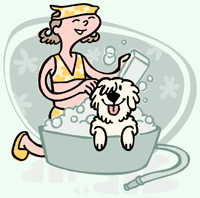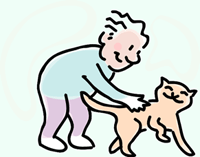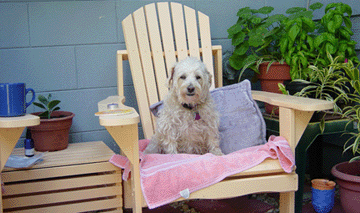

Natural Flea Control for Your Furry Family Member
We just found out about this great new method of natural flea control called Anibio Tick Clip, for Dogs and Cats. It's a tag that harnesses the power of the bioenergetic field around your pet to create an energy barrier that repels fleas, ticks & mosquitos for two years. This insect repellent collar tag was created in Germany and has been a huge success with pets throughout Europe. Here are some great reasons to try it: Absolutely non-toxic I know we're going to try it on our little furry family! The FleaIn order to use natural flea control on your pet, it's really important to understand the lifecycle of the flea and just what their purpose in the natural scheme of things is.Fleas are non-winged insects with such powerful hind legs that they can jump 9 inches in the air or 5 feet sideways. They feed only on blood, and most of their lifecycle is spent off the host animal. They only invade our pets when they need a transfusion. Contrary to popular belief, female fleas do not prefer to lay their eggs on your pet, but instead in dark damp places like cracks in the floor or a damp corner in your basement. They can lay up to 20 eggs at a time or as many as 400 eggs in their lifetime. Most eggs are laid during high humidity and moderate temperatures. Once the eggs are laid it only takes about a week for them to hatch. The next stage is the larval stage which can last anywhere from 10 to 200 days. Then the larva spins a cocoon and can pupate anywhere from 10 to 200 days. Whew! That means one pair of adult fleas can cause you to be infested for up to 2 years! Combine that with the fact the most pesticides only kill adult fleas, and you realize why it's so difficult to get rid of those pesky little vampires who chew on your pet's flesh until blood appears. Then they drink the blood until they are bloated. Fortunately for your pet, once the flea is full they won't have to drink again for up to 2 months. How do you know if your pet has fleas? Examine your pet to assess the situation. If it's a severe case you'll actually see fleas swarming all over their skin. If you don't visibly see any fleas, examine the area around the base of the tail. If you see black particles in the fur, that is flea feces. If you determine that your pet does have fleas, your first inclination might be to run out to the store and get the strongest thing you can possibly find in the pet section to get rid of them. Did you know that many of today's insecticides originated in chemical warfare agents? Do you really want to put that on your beloved pet? Organophosphates and carbamares are the two main pesticides found in flea treatments. Both are nerve paralyzing agents that can cause convulsions, nausea and respiratory failure in not only the flea but also the host animal. It can also be harmful to you and your family if you happen to come in contact with it. It's really important that when you find the fleas you don't let your desperation to get rid of the fleas lead you to making a decision that can harm your pet and your family. Long term effects can lead to kidney failure and and other medical complications. TreatmentTheir are 3 natural flea control fighters that are being used on the market today. One is a type of pyrethin derived from chrysanthemums, the other, d-Limonene, is a by-product of the citrus industry. Both of these are less toxic, but they should still be used with caution.The third natural flea control fighter is the safest way. It's called Diatomaceous Earth (Food Grade) and is completely safe. Diatomaceous earth is fossilized algae that is like a chalky dust. It has sharp edges that penetrate the outer shell of the flea causing it to dehydrate and die. Not only does this dynamo dust work on fleas, but just about any other insect you can possibly imagine. Natural Flea Control is never a one time thing. It requires endless attention. Here are some things you can do for natural flea control:  Thoroughly clean your home - Make sure you vacuum frequently, especially in pet areas. Pay special attention
to damp,
dark places. When you're finished vacuuming dispose of the bag by burning it or sealing it in a plastic garbage bag
and putting
in the outside trash. Next, wash your pet's bedding and sprinkle it with
Diatomaceous Earth (please make sure you use food grade diatomaceous earth and not the kind that is meant for swimming pools, which is
actually toxic)afterwards. Also sprinkle DiatomaceousEarth on the carpets and other upholstery and work in with a broom.
I have a great little
Garden Duster that I found which actually
sprays the powder out so it's easier to spread it. You may want to try that also, but make sure you wear a mask and put your pets
in another room if you use this method so neither of you breathe in the dust. After a couple of days you can vacuum any remaining
powder up, as it takes about 48 hours for it to kill the fleas. Thoroughly clean your home - Make sure you vacuum frequently, especially in pet areas. Pay special attention
to damp,
dark places. When you're finished vacuuming dispose of the bag by burning it or sealing it in a plastic garbage bag
and putting
in the outside trash. Next, wash your pet's bedding and sprinkle it with
Diatomaceous Earth (please make sure you use food grade diatomaceous earth and not the kind that is meant for swimming pools, which is
actually toxic)afterwards. Also sprinkle DiatomaceousEarth on the carpets and other upholstery and work in with a broom.
I have a great little
Garden Duster that I found which actually
sprays the powder out so it's easier to spread it. You may want to try that also, but make sure you wear a mask and put your pets
in another room if you use this method so neither of you breathe in the dust. After a couple of days you can vacuum any remaining
powder up, as it takes about 48 hours for it to kill the fleas.
Unfortunately, if you have a severe infestation it may be necessary to "bomb" your house with a commercial pesticide before you implement your natural flea control plan. If you find that you must do this make sure you search for a product that contains pyrethrins or resmethrin as the active ingredient. These are the least toxic. Also make sure to follow the instructions exactly as they are written. The health of your pet's skin - Fleas tend to be more apt to "attack" pets that are in an unhealthy state then those who are healthy. That's because they don't have to work as hard to get the blood. If your pet's skin is itchy and allergy prone it actually falls apart and bleeds. Then the fleas don't have to chew to get the blood. In most situations a pet with unhealthy skin can be healed with a proper diet.  Frequent grooming is a very important step for natural flea control. Bathing your pet about every 10 dayswill help
keep fleas at bay. Using a mild organic shampoo on your pet will drown most of the fleas. After the shampoo spongea lemon rinse on your dog (don't use lemon on cats, as they don't tolerate citrus) to keep the fleas away. Frequent grooming is a very important step for natural flea control. Bathing your pet about every 10 dayswill help
keep fleas at bay. Using a mild organic shampoo on your pet will drown most of the fleas. After the shampoo spongea lemon rinse on your dog (don't use lemon on cats, as they don't tolerate citrus) to keep the fleas away.
Drop a sliced lemon, peel and all, into a pint of boiling water and let steep overnight. After you've sponged your dog with the lemon rinse allow it to air dry. You can also sponge the lemon rinse on daily until the skin condition improves. In between shampoos, make sure you brush your pet regularly and use a flea comb to remove as many fleas as you can. Other Natural Flea Control Remedies * Herbal Sprays, Shampoos and Flea collars - You can find a great variety of these products at Only Natural Pet Store. * Natural Herbs - If you want to make your own herbal remedy, you can use these common ingredients that can be used daily and are not harmful: pennyroyal, citronella, rosemary and wormwood. Try steeping the dried herbs and making a spray, or make your own herbal flea collar. How to Make Your Own Flea Collar  *Brewer's Yeast, Garlic & Zinc - A daily dose of these will make your pet's skin unattractive to fleas. You can buy brewer's yeast
at just about any health food store. Add 1-3 minced garlic cloves and 1 tsp to 1 TBS of brewer's yeast (the larger your pet, the
the more they should get) to your pet's food every day. Use about 10 mg of chelated zinc for cats and small dogs and up to
20 mgs on larger dogs. It will take about a month for it to take effect. You can also dust your pet and your pet's bedding
with brewer's yeast as an extra measure. It is totally harmless to your pet. For a more simple solution, Only Natural Pet Store makes an easily
digestible
Garlic & Brewer's Yeast Tablet . We've tried these and they work great plus the animals love them! *Brewer's Yeast, Garlic & Zinc - A daily dose of these will make your pet's skin unattractive to fleas. You can buy brewer's yeast
at just about any health food store. Add 1-3 minced garlic cloves and 1 tsp to 1 TBS of brewer's yeast (the larger your pet, the
the more they should get) to your pet's food every day. Use about 10 mg of chelated zinc for cats and small dogs and up to
20 mgs on larger dogs. It will take about a month for it to take effect. You can also dust your pet and your pet's bedding
with brewer's yeast as an extra measure. It is totally harmless to your pet. For a more simple solution, Only Natural Pet Store makes an easily
digestible
Garlic & Brewer's Yeast Tablet . We've tried these and they work great plus the animals love them!
* Apple Cider Vinegar - Although I haven't tried this myself, I have heard that it is an effective method of natural flea control. Use about 3 TBS per every gallon of your pet's drinking water. Also, mix it with water and use as a spray on your pet. Kind of stinky, I'll bet, but if it works it's worth it. * Lavender Oil - Add a little pure essential lavender oil to your pet's rinse water or put in a spray bottle with water and spraythem daily. Please do not rub any pure essential oils directly on your pet, especially cats, as this can be very harmful. * Neem Oil - Look for natural flea control shampoos or sprays that contain neem oil. It is very effective in the natural fleacontrol fight.
As you can see, natural flea control is really just a matter of maintenance, diligience and patience. In the long run, though,your pet will be healthier and safer. After all, don't you want the best for your furry family member? // --> Return from Natural Flea Control to Natural Pet |























